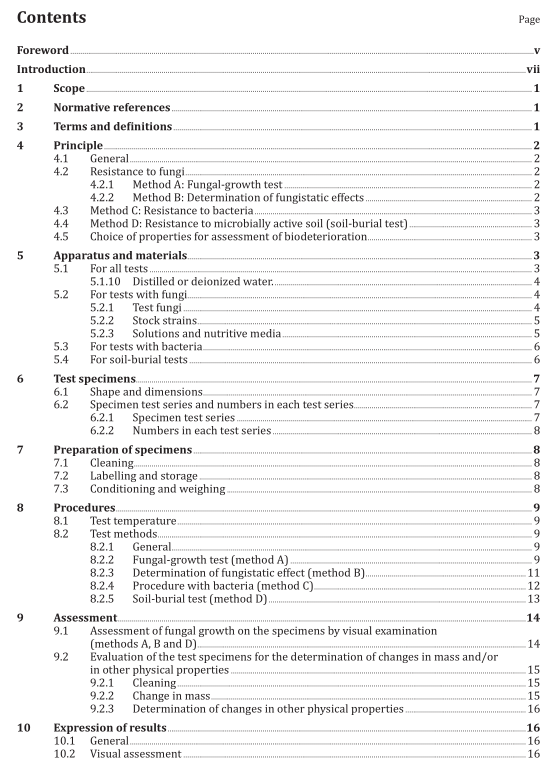BS EN ISO 846 pdf download

BS EN ISO 846 pdf download Plastics – Evaluation of the action of microorganisms
1 Scope
This document specifies methods for determining the deterioration of plastics due to the action of fungiand bacteria and soil microorganisms. The aim is not to determine the biodegradability of plastics orthe deterioration of natural fibre composites.
The type and extent of deterioration can be determined bya) visual examination and/or
b) changes in mass and/or
c) changes in other physical properties.
The tests are applicable to all plastics that have an even surface and that can thus be easily cleaned.Theexceptions are porous materials, such as plastic foams.
This document uses the same test fungi as IEC 60068-2-10.The IEC method, which uses so-called“assembled specimens”, calls for inoculation of the specimens with a spore suspension,incubationof the inoculated specimens and assessment of the fungal growth as well as any physical attack onthe specimens.
The volume of testing and the test strains used depend on the application envisaged for the plastic.
2Normative references
The following documents are referred to in the text in such a way that some or all of their contentconstitutes requirements of this document. For dated references, only the edition cited applies. Forundated references, the latest edition of the referenced document (including any amendments) applies.ISO 13934-1:2013,Textiles —Tensile properties of fabrics — Part 1: Determination of maximum force andelongation at maximum force using the strip method
EN 10088-1, Stainless steels — Part 1: List of stainless steels
EN 10088-2, Stainless steels — Part 2: Technical delivery conditions for sheet/plate and strip corrosionresisting steels for general purposes
EN 13697:2015,Chemical disinfectants and antiseptics – Quantitative non-porous surface testfor the evaluation of bactericidal and/or fungicidal activity of chemical disinfectants used in food,industrial, domestic and institutional areas -Test method and requirements without mechanical action(phase 2,step 2)
IEC.60068-2-10,Environmental testing —Part 2-10:Tests —Test ]J and guidance: Mould growth
3Terms and definitions
For the purposes of this document, the following terms and definitions apply.
IlS0 and lEC maintain terminological databases for use in standardization at the following addresses:-ISO Online browsing platform: available at https://www.iso.org/obp
—IEC Electropedia: available at http://www.electropedia.org/
3.1
biodeterioration
undesired change in the properties, such as colour, strength, mass, of a material due to the action of amicroorganism
3.2
fungistatic effect
antimycotic effect of an antimicrobial treatment which prevents a given material from being overgrownby fungi under moist conditions
4 Principle
4.1General
The test involves exposing test specimens of plastic to the action of selected test strains of fungi andbacteria (or, in the case of the soi-burial test, to microbially active soil) for specified or agreed periodsof time under specified conditions of temperature and humidity.
At the end of the exposure, the test specimens are assessed before and/or after cleaning by visualexamination and/or any change in mass or other physical properties is determined.
The results obtained with the specimens exposed to microorganisms (test series l) are compared withthose obtained from retained reference specimens (test series 0) or sterile specimens (test series S)kept under the same conditions.
In the case of testing fungistatic properties, a visual assessment is made between test specimens free ofbiocides and with those containing biocides to demonstrate the effect of a biocide in a qualitative manner.Short descriptions of the test methods used to determine the resistance of plastics to fungi(method A)or the fungistatic effects (method B), resistance to bacteria (method C) and resistance to soilmicroorganisms (method D) are given in 4.2 to 4.4.
4.2 Resistance to fungi
4.2.1 Method A: Fungal-growth test
Test specimens are exposed to a mixed suspension of fungal spores in the presence of a humidity ≥95 %relative humidity.After the limited nutrients from the spore itself are depleted through formation ofa germination tube, the fungi can only grow at the expense of the material of the test specimens. Ifthe specimens contain no nutritive component, the fungi cannot develop mycelia and there will be nodeterioration of the plastic.
Method A is suitable for the assessment of the inherent resistance of plastics to fungal attack in theabsence of other organic matter.









